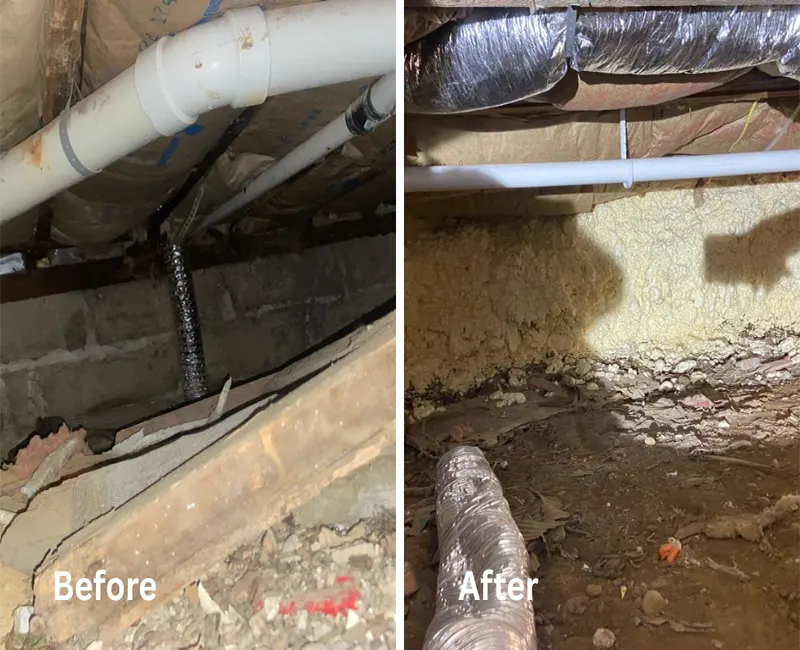Fall may feel like a break after the heavy pollen in spring and summer, but it can be tough for families. That’s when allergies inside the home often get worse. When you close the windows, if the air is damp, and when you turn the heat on for the first time, it can make dust, mold, and pet dander move around your home. If you don’t have good insulation to seal up leaks or handle moisture, all these things will get into your living areas and make it hard to feel good.
At Zavza Seal, we work for our neighbors. We offer a variety of insulation upgrades to increase energy efficiency, seal out unwanted drafts, and create a healthier indoor living environment to help you keep some of those allergies from bothering you this fall and winter. A lot of our customers tell us they see savings each month on their energy bills. They also feel comfortable in their homes all year round. The right insulation can make your home’s air feel better. It helps keep you healthy and makes your home feel safe for your family.
Schedule Your Free Fall Insulation Assessment With Zavza Seal! Because We Care About Your Comfort and Health!
Understanding Fall Allergies
Fall brings crisp air and colorful leaves, but it also shifts the battle with fall allergens indoors. As windows close and heating systems kick on, irritants that were once outside get trapped and concentrated inside the home.
- Dust Mites: Thrive in warm, enclosed spaces and leave behind allergenic waste particles
- Mold Spores: Released when damp leaves decay and indoor humidity rises
- Pet Dander: Lingers longer in sealed homes without fresh air exchange
- Pollen Carryover: Ragweed and late grass pollen cling to clothing and enter homes
- First Furnace Cycle: Stirs up dust, mold fragments, and fine particulates from ducts
Allergies Affected Most in Fall:
- Allergic Rhinitis: Sneezing, runny nose, itchy eyes
- Asthma: Wheezing and bronchial inflammation from mold and dust inhalation
- Hypersensitivity Pneumonitis: Immune-driven lung inflammation from mold spores
- Atopic Dermatitis: Skin flare-ups triggered by indoor allergens
For Long Island, New York City, and other coastal homes, the risks are even greater. Humid autumn weather feeds mold growth in basements and crawl spaces. Older housing stock in the boroughs often lacks proper air sealing, leaving homes drafty and vulnerable to airborne allergens. Together, these factors create the perfect storm for poor indoor air quality during the fall months.
Mold, Dust, and Allergens in Insulation
Insulation plays a crucial role in maintaining comfort and energy efficiency. But when it becomes wet, dirty, or aged, it can turn into a hidden health hazard. Instead of blocking contaminants, old or poorly installed insulation traps moisture, dust, and organic debris that feed mold and bacteria. Over time, these pollutants recirculate through your home’s air system, worsening allergies, asthma, and other respiratory issues.
Common Contaminants Found in Compromised Insulation:
- Damp Fiberglass Batts: Absorb moisture and support mold colonization
- Dust Reservoirs: Layers of fine dust trapped in blown-in insulation circulate when air moves
- Pest Contamination: Droppings, urine, and nesting debris act as potent allergen sources
- VOC Release: Degraded adhesives or coatings in older insulation contribute to poor air quality
- Microbial Growth: Bacteria and mold thrive in cellulose and organic dust trapped in insulation
Pest activity adds another layer of risk. Rodents and insects often nest inside insulation, leaving behind droppings and debris that contaminate the material and worsen respiratory symptoms. What should act as a barrier to outdoor air ends up acting like a sponge for allergens, silently undermining your indoor air quality.
How Insulation Improves Indoor Air Quality
Insulation does more than keep your home warm in winter and cool in summer. It plays a major role in maintaining the health of your indoor environment. Properly installed insulation seals gaps, regulates temperature, and controls moisture; three factors directly tied to mold growth, dust circulation, and overall air quality. When insulation breaks down or leaves gaps, it creates invisible pathways for allergens like pollen, vehicle exhaust, and moisture to enter and circulate.
By improving insulation and sealing your home’s envelope, you not only reduce energy loss but also create a healthier, more breathable space for your family.
How Insulation Supports Cleaner Air:
- Air Sealing: Stops ragweed pollen, dust, and vehicle particulates from slipping through cracks, seams, and unsealed penetrations.
- Moisture Control: By keeping indoor surfaces dry, insulation reduces the conditions that allow spores to thrive in attics, crawl spaces, and basements.
- Temperature Regulation: Stable surface temperatures prevent the damp film that feeds both mold colonies and dust mite activity.
- Sound and Draft Control: Sealing out drafts quiets your living space and prevents the movement of particles and contaminants between rooms.
The combined effect is a cleaner, more stable indoor environment where allergens have fewer opportunities to gain a foothold.
Best Insulation Upgrades for Allergy Relief
If you or your family suffer from allergies, the right insulation upgrades can make a measurable difference in your comfort and air quality. Not all insulation products perform equally. Some resist mold and dust far better than others, and the wrong choice can actually worsen allergy symptoms. Insulation material type, age, and installation quality all influence how effectively insulation keeps out airborne irritants and excess moisture.
Best Insulation Types for Allergy Control:
- Spray Foam Insulation: Spray foam insulation is excellent at blocking drafts and outdoor allergens while reducing condensation risk in basements, rim joists, and attics. It seals every gap, improving energy efficiency and keeping moisture out of problem areas.
- Blown-In Cellulose Insulation: Blown-in cellulose insulation uses treated fibers that help resist mold, moisture, and insect activity, making it a solid option for wall cavities and attic retrofits. It’s especially effective in older homes with irregular framing or hard-to-reach spaces.
- Fiberglass Insulation: Fiberglass insulation performs well when installed correctly, providing consistent coverage and energy savings. However, gaps or compression can create pockets where dust, mold, and allergens collect; especially in attics and crawl spaces with poor ventilation.
- Rockwool Insulation: Rockwool insulation performs exceptionally well in moisture-prone areas like basements and crawl spaces because it resists water absorption and mold colonization. It also provides superior fire resistance and noise reduction, improving overall indoor comfort.
- Insulation Replacement or Upgrade: Insulation replacement or upgrade is essential for homes with material over 15–20 years old, as aging insulation often harbors dust, allergens, and moisture. New insulation enhances comfort, lowers energy bills, and improves indoor air quality throughout the home.
Best Fall HVAC and Filtration Upgrades for Allergy Prevention
Insulation sets the foundation, but your heating and cooling system determines how air moves through the home. Upgrades here can dramatically cut allergens.
- Filters: MERV 13 and HEPA Benefits: MERV 13 filters trap particles as small as 0.3 microns, capturing mold spores, pollen, and dust mite waste. Portable HEPA units can supplement central systems in bedrooms and living areas.
- Duct Cleaning and Sealing: Unsealed or dirty ducts leak dust and pull in attic or crawl space contaminants. Professional sealing keeps air clean and ensures your system only circulates conditioned, filtered air.
- Humidity Control: Dehumidifiers or whole-home humidity systems keep indoor levels between 40 and 50 percent. This range discourages dust mites and mold without drying out sinuses.
- Ventilation Strategies: Energy recovery ventilators (ERVs) and heat recovery ventilators (HRVs) exchange stale indoor air with filtered outdoor air, reducing indoor pollutant buildup while maintaining comfort and efficiency.

Case Study: Closed-Cell Spray Foam Crawl Space Insulation in Valley Stream, NY
The Problem:
A homeowner in Valley Stream, NY contacted Zavza Seal LLC after noticing cold drafts and musty odors near the front of their home. Rising energy bills and poor air quality pointed to a failing crawl-space insulation system. On inspection, our team found deteriorated insulation across roughly 272 sq. ft., along with an uninsulated access door that allowed cold air and moisture to enter.
The Solution:
Zavza Seal recommended closed-cell spray foam insulation; a high-performance material that provides superior thermal resistance and moisture control.
- Old Insulation Removal: All deteriorated insulation was safely removed.
- Spray-foam Installation: Closed-cell foam was applied to all four walls, rim joists, and 2×6 rafters, achieving R-21 walls and R-38.5 ceiling values.
- Access-door Upgrade: The new 36″×36″ crawl-space door was fully sealed and insulated with spray foam to eliminate air infiltration.
The Results:
Immediately after installation, the homeowner reported warmer floors, cleaner air, and lower heating demand. The crawl space is now a sealed thermal barrier that blocks drafts, moisture, and allergens, improving comfort and long-term efficiency throughout the home. See case study here.
Looking for Crawl-Space Insulation Near Valley Stream, NY? Contact Us for a Free Insulation Assessment!
Fall Cleaning and Maintenance Habits
Even the best insulation and filtration cannot protect you if allergens build up inside the living space. Regular fall cleaning and maintenance habits make the difference.
- Vacuuming With HEPA Vacuums: HEPA-equipped vacuums remove dust, pet dander, and mold fragments instead of redistributing them into the air.
- Washing Bedding Weekly: Sheets and pillowcases collect dust mite waste and skin cells. Weekly hot water washes reduce allergen load significantly.
- Removing Shoes and Outdoor Clothing: Shoes and jackets carry ragweed pollen, mold spores, and leaf debris indoors. Create a habit of removing them at entry points.
- Safe Leaf Cleanup: Wet leaves release spores that cling to clothing and pets. Wear a mask when raking, and clean up thoroughly before going inside.
Poor Air Quality Prevention Checklist for Homeowners
Seasonal changes can trigger hidden moisture, poor air quality, and even mold growth inside your home. Fall is the perfect time to prepare your property for the colder, wetter months ahead. With a few simple maintenance steps, homeowners can prevent leaks, improve indoor air quality, and avoid costly repairs later in the season.
Use this quick homeowner checklist to stay proactive and protect your investment before winter sets in:
Homeowner Checklist:
- Check Insulation in Attic and Basement: Ensure proper coverage to prevent condensation and heat loss.
- Maintain 40–50% Indoor Humidity: Use dehumidifiers or ventilation to control moisture.
- Replace HVAC Filters Monthly: Improve air circulation and reduce allergens.
- Clean Gutters to Prevent Leaks: Keep rainwater flowing away from the foundation.
- Schedule Fall Inspection With Zavza Seal: Identify and fix moisture issues before they escalate.
Fall Allergy Tips for Indoor Air Quality: Final Thoughts
Better insulation equals cleaner air and fewer allergy flare-ups this fall. Acting before winter arrives keeps allergens from becoming trapped inside your home, improving both comfort and air quality. Zavza Seal offers proven insulation types that increase energy efficiency and breathe healthier air this winter.
Don’t Wait Until Winter! Schedule Your Free Fall Insulation and Air Quality Assessment With Zavza Seal Now!
Frequently Asked Questions About Fall Allergies and Insulation
Why do my allergies get worse in the fall even after pollen season?
When outdoor pollen levels drop, indoor allergens take over. Dust mites, mold spores, and pet dander build up in closed spaces once windows are shut and heating systems start running. These irritants circulate through the air, especially in older or poorly sealed homes.
How does insulation help improve indoor air quality?
Proper insulation seals gaps and cracks where outdoor air, dust, and pollen enter. It also keeps indoor humidity stable, reducing mold and dust mite growth. The result is cleaner, more breathable air throughout your home.
Can old insulation make my allergies worse?
Yes. Aging or damaged insulation often traps dust, absorbs moisture, and becomes a breeding ground for mold and bacteria. It can also harbor pest droppings and release volatile organic compounds (VOCs) over time, all of which worsen allergy symptoms.
What are the signs that insulation is affecting my air quality?
Common signs include musty odors, increased sneezing or coughing indoors, visible mold or staining near insulation areas, higher humidity levels, and worsened allergy symptoms when the HVAC system runs.
What type of insulation is best for allergy prevention?
- Spray Foam: Excellent air seal and moisture control.
- Rockwool: Mold- and water-resistant; ideal for basements.
- Blown-In Cellulose: Treated to resist mold and insects.
- Fiberglass Batts: Effective only when properly installed without gaps or compression.
Each home may require a combination based on age, structure, and humidity.
How often should insulation be replaced to maintain good air quality?
Most insulation lasts 15–20 years, but it should be inspected every few years for moisture, mold, or pest activity. If your home feels drafty or you notice rising energy bills or allergy flare-ups, it’s time for an evaluation.
What other steps can I take to reduce fall allergens indoors?
- Replace HVAC filters monthly (use MERV 13 or higher).
- Clean ducts and vents regularly.
- Maintain indoor humidity between 40–50%.
- Vacuum weekly with a HEPA vacuum.
- Wash bedding in hot water weekly.
- Use air purifiers in bedrooms and main living areas.
Does insulation help with asthma or COPD symptoms?
Yes, indirectly. By keeping indoor air dry and free of mold spores and dust, proper insulation reduces respiratory irritants that can trigger asthma attacks or COPD flare-ups, especially during the damp fall months.
Why is insulation especially important for Long Island and NYC homes?
The region’s older buildings and humid coastal climate create ideal conditions for moisture intrusion and mold growth. Proper air sealing and insulation protect against these issues, improving both energy efficiency and indoor air quality.
How can I tell if my home needs an insulation upgrade?
Schedule an insulation and air quality assessment if you notice:
- Drafty rooms or uneven temperatures
- Condensation or dampness in basements
- Musty odors or visible mold
- Rising heating bills
- Allergy or asthma symptoms that worsen indoors
Can insulation lower my energy bills too?
Absolutely. Properly sealed and insulated homes retain heat more efficiently, reducing strain on your furnace and cutting monthly utility costs. Many Zavza Seal customers report significant savings within the first season after installation.
How can I schedule a free insulation assessment?
Contact Zavza Seal today to schedule your Free Fall Insulation and Air Quality Assessment. Our team will inspect your attic, crawl space, and basement for moisture, air leaks, and insulation performance, and provide recommendations to keep your home healthy and comfortable year-round.








